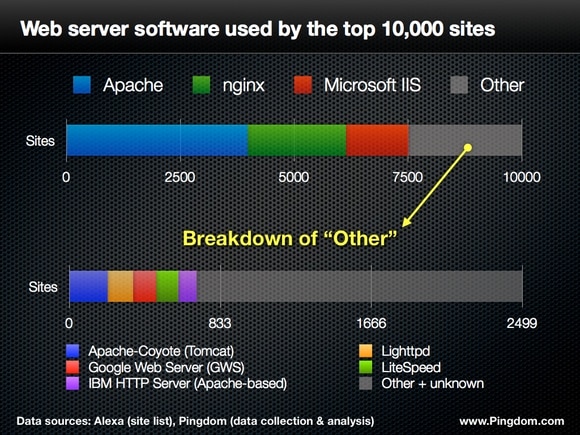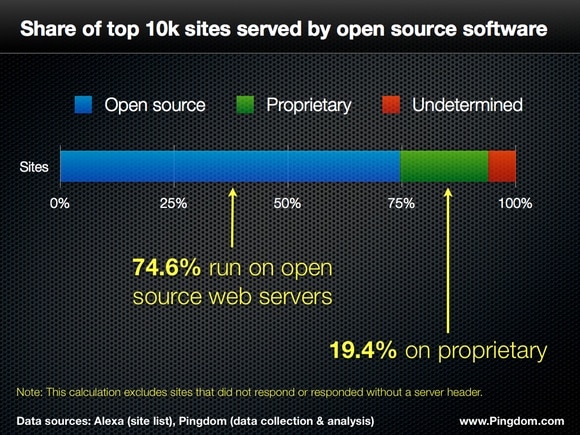
We have analyzed the top 10,000 websites in the world to find out what web server software they are running. Here is what we found out.
First of all, it is clear that open source software rules the roster. This largely thanks to two massively popular open source projects: The Apache web server, and the nginx web server. Together they account for at least 61% of the top 10k sites.
The main competitor to these is Microsoft’s IIS, with just under 14% of the sites. IIS, needless to say, isn’t open source.
These three web servers are far from alone, though. Others that make an appearance in the top 10k include Lighttpd, Apache’s Tomcat, LiteSpeed, Resin, Zeus, Jetty, Tengine and many others. (For our methodology, check out the bottom of this article.)
Web servers used by the top 10k sites
When you break it down visually, it’s obvious how dominant Apache is. That said, nginx has risen quickly over the past few years and is becoming quite a contender. It has even passed Microsoft’s IIS, which used to hold the second place after Apache.

Larger PNG version available.
It’s worth noting here that nginx is sometimes used as a reverse proxy, often in combination with Apache, so behind some of those nginx numbers there are also Apache web servers.
We have included a more comprehensive list at the bottom this article if you want to look closer at the numbers.
Open source dominance
We have mentioned before how the Web could be considered the greatest triumph of open source software, and this clearly extends to web server software. At least 75% of the sites use open source web servers.

Larger PNG version available.
When calculating the percentages above, we excluded the 1/10th of the sites that either didn’t respond, or didn’t include a server header in the response. If we had included them in the “undetermined” section in the chart, we would have had 66.8% open source, 17.3% proprietary, and 15.9% undetermined.
Some additional notes and thoughts
- Web accelerator service CloudFlare is in the house. Out of the top 10k, 79 sites responded with server “cloudflare-nginx” (we folded those into the nginx numbers).
- Amusingly, a few sites felt the need to point out that the server was confidential, instead of just leaving that header out.
- Thanks to the large number of localized Google Search sites that show up in the top 10k, Google’s web server (GWS) made a strong appearance with 128 sites.
- If we ignore the sites that didn’t respond or identify themselves with a server header, Apache’s share goes up from 39.8% to 44.4%, nginx goes from 21.6% to 24.2%, and IIS goes from 13.6% to 15.2%.
More web servers…
As we promised, here is a table with a more detailed breakdown of the web servers we found.
| Web server | Number of sites |
|---|---|
| Apache | 3975 |
| nginx | 2164 |
| Microsoft IIS | 1362 |
| Apache-Coyote (Tomcat) | 211 |
| Lighttpd | 141 |
| Google Web Server (GWS) | 128 |
| LiteSpeed | 120 |
| IBM HTTP Server (Apache-based) | 101 |
| Microsoft PWS | 30 |
| Sun ONE | 27 |
| Resin | 25 |
| Google Servlet Engine (GSE) | 22 |
| Yahoo/Apache Traffic Server (YTS/ATS) | 17 |
| Zeus | 15 |
| Google Frontend (GFE) | 14 |
| Sun Java System | 13 |
| Oracle Application Server | 13 |
| Tengine (nginx-based) | 13 |
| ECS | 12 |
| Jetty | 12 |
That isn’t a complete list, though. If you absolutely want to see every single web server included, we have attached a zipped CSV file where you can check out the raw server headers if you’re interested in that kind of thing.
Final words
Open source projects help drive web technology forward, and web servers is no exception. As a bonus, the diverse landscape we’re seeing should spur on competition among the different development teams. For example, we suspect the rise of nginx has given the Apache team some extra motivation and inspiration, and vice versa.
Sometimes the web server landscape may seem like a three-horse race between Apache, nginx and IIS, but as you can see, there are many other web servers out there. One size doesn’t fit all, so we’re happy to see this kind of diversity.
Methodology: The starting point for this survey was the top 1M sites list (in the world) provided by Alexa. We extracted the top 10k from this list, and downloaded the server response headers from each of the sites. The vast majority identify their web server software with the “Server” header. We got the server id for roughly 90% of the sites this way.



























